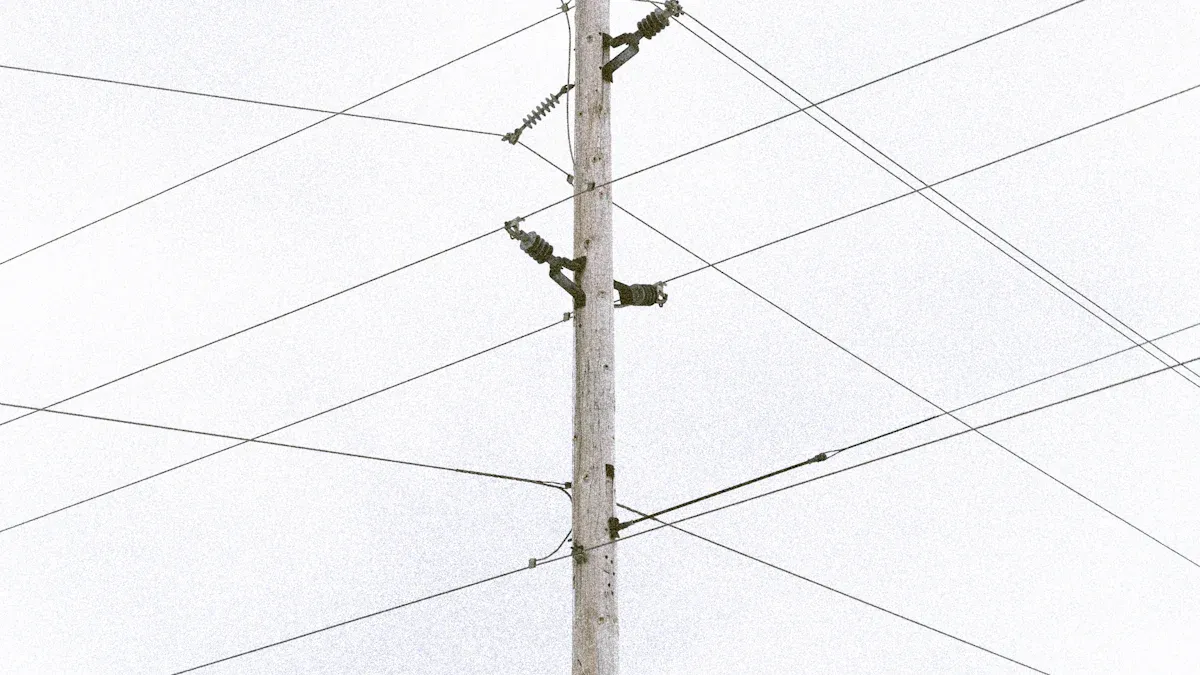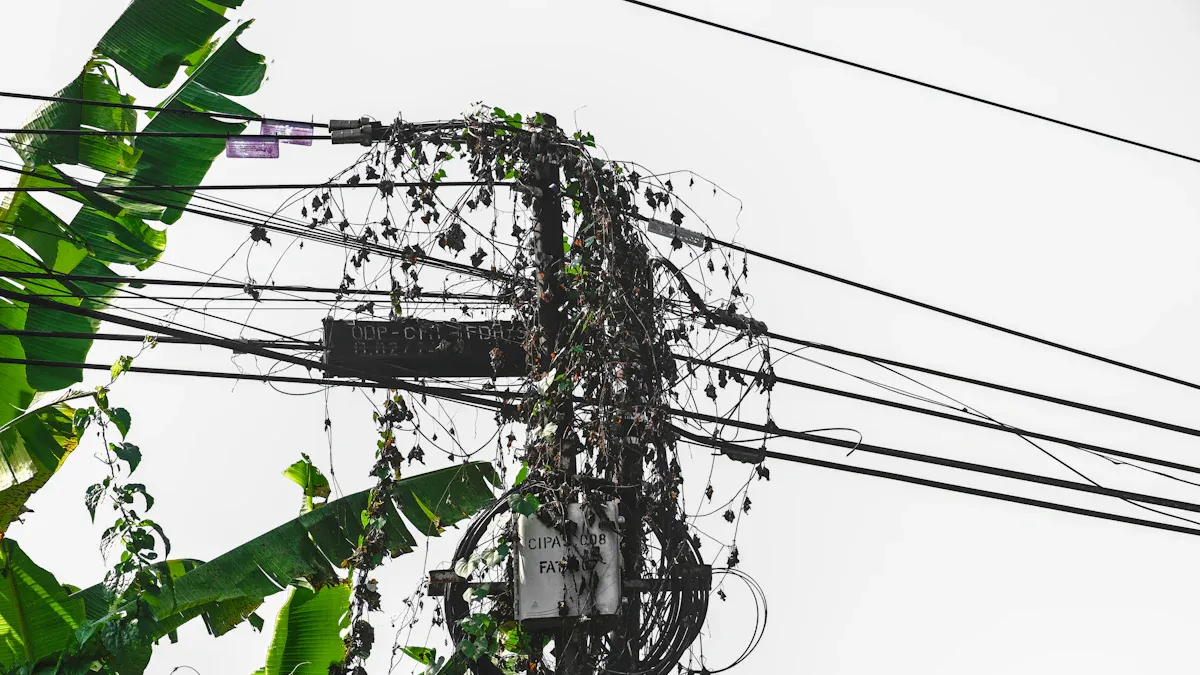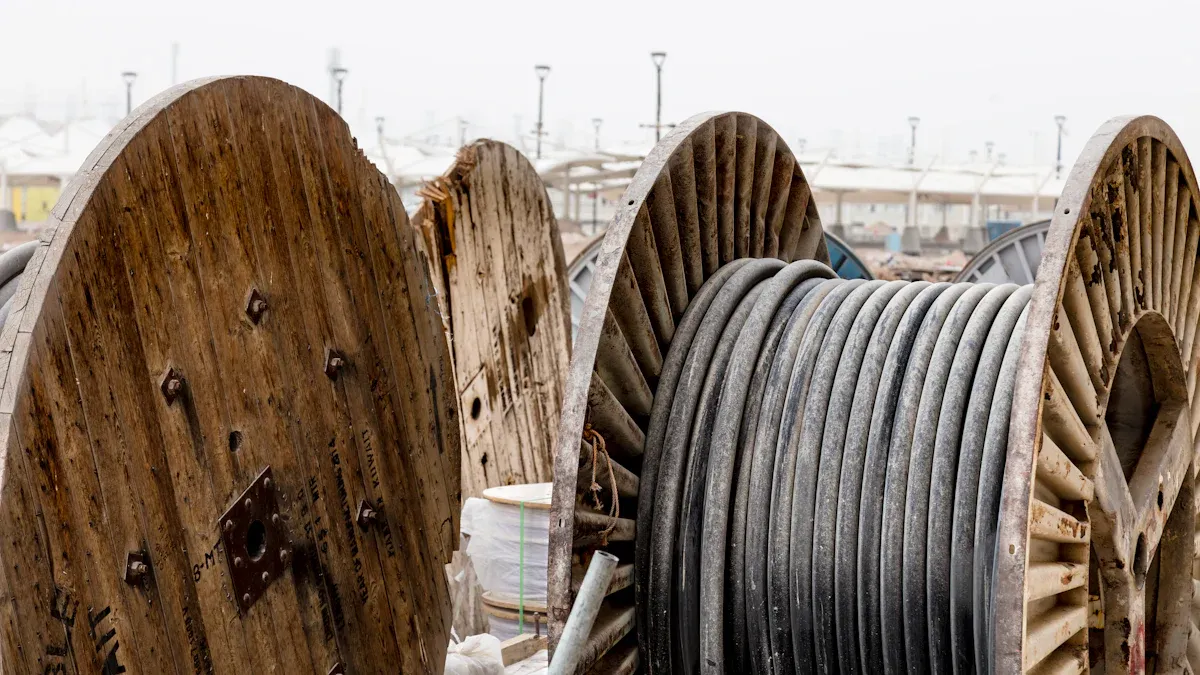
ADSS Cable Support Clamps are essential for stabilizing utility pole deployments. These ADSS cable clamps secure cables, preventing sagging and potential damage. Proper maintenance of the ADSS clamp ensures it functions effectively, reducing the risk of system failures. Regular upkeep minimizes downtime, enhances reliability, and extends the lifespan of the entire infrastructure. Neglecting maintenance can lead to costly repairs or interruptions.
Key Takeaways
- Checking ADSS cable clamps often is very important. Inspect them every three months, or every month in bad weather, to find problems early and keep the system working well.
- Installing ADSS clamps the right way is very important. Follow the rules and use proper tools to make sure they hold and stay steady.
- Write down all maintenance work. Keep notes on checks and fixes to see how they perform over time and stay responsible for upkeep.
Understanding ADSS Cable Support Clamps

Role of ADSS Cable Support Clamps
ADSS Cable Support Clamps play a vital role in securing fiber optic cables in utility pole deployments. These clamps ensure that cables remain stable, preventing sagging and minimizing stress at critical points. By maintaining proper alignment, they help preserve the integrity of the cable network, which is essential for uninterrupted telecommunications. Suspension clamps, for instance, are specifically designed to reduce bending and stress, ensuring reliable performance even under extreme environmental conditions. Additionally, their lightweight design and ease of installation contribute to faster deployment and lower costs for service providers.
Importance in Utility Pole Deployments
In utility pole deployments, ADSS Cable Support Clamps are indispensable for maintaining network stability. They are engineered to withstand harsh weather conditions, including high winds and heavy snow loads. Proper support and suspension prevent cable damage caused by excessive tension or environmental factors. The clamps also ensure that the cables remain securely attached to poles or towers, reducing the risk of system failures. A comprehensive installation plan, including diagrams and safety measures, further enhances their effectiveness in utility applications.
Key Features and Materials
ADSS Cable Support Clamps are designed to accommodate specific cable diameters, ensuring a snug fit and optimal support. Key features include gentle bushings that provide a secure groove fit without damaging the cable. Common materials used in these clamps include aluminum clad, rubber, and armor grip, which offer durability and resistance to corrosion. Essential hardware components, such as bolts, nuts, and brackets, enhance their functionality. Suspension clamps, tension clamps, and preformed dead ends are among the various types available, each serving a unique purpose in cable management.
Inspection and Maintenance Schedule
Frequency of Inspections
Regular inspections are essential to ensure the longevity and performance of ADSS Cable Support Clamps. Utility professionals should establish a consistent inspection schedule based on the operational environment and the criticality of the infrastructure. For most deployments, quarterly inspections are recommended. However, in areas prone to extreme weather conditions, monthly checks may be necessary to identify potential issues early.
Tip: After severe weather events, such as storms or heavy snowfall, conduct immediate inspections to assess any damage or misalignment.
A proactive approach to inspection helps prevent minor issues from escalating into costly repairs. By adhering to a well-defined schedule, technicians can maintain the reliability of the cable network and minimize unexpected downtime.
Key Inspection Points
During each inspection, technicians should focus on specific components and areas to ensure comprehensive maintenance. Key inspection points include:
- Clamp Integrity: Check for cracks, deformities, or signs of wear on the clamps. Damaged clamps can compromise cable stability.
- Cable Alignment: Ensure that cables are properly seated within the clamps without sagging or excessive tension.
- Hardware Condition: Inspect bolts, nuts, and brackets for rust, looseness, or missing parts. Tighten or replace components as needed.
- Bushing Wear: Examine the bushings for signs of deterioration. Worn bushings can lead to cable abrasion and eventual failure.
Note: Use a checklist during inspections to ensure no critical component is overlooked.
Technicians should document their findings and address any issues promptly. This systematic approach ensures that ADSS Cable Support Clamps remain in optimal condition.
Environmental and Seasonal Factors
Environmental and seasonal factors significantly impact the performance of ADSS Cable Support Clamps. Extreme temperatures, high humidity, and exposure to UV radiation can accelerate material degradation. In regions with heavy snowfall or ice accumulation, clamps may experience additional stress due to increased cable weight.
To mitigate these challenges, technicians should:
- Apply corrosion-resistant coatings to metal components in coastal or high-humidity areas.
- Use UV-resistant materials for clamps exposed to prolonged sunlight.
- Perform seasonal inspections before and after winter to address potential damage caused by ice or snow.
Reminder: Adjust the inspection frequency based on the local climate and environmental conditions to ensure year-round reliability.
By accounting for these factors, utility providers can enhance the durability and performance of their cable support systems.
Common Issues and Troubleshooting
Identifying Wear and Tear
Wear and tear on ADSS Cable Support Clamps can compromise the stability of utility pole deployments. Technicians should look for visible signs such as cracks, deformation, or discoloration on the clamps. These issues often indicate material fatigue or exposure to harsh environmental conditions. Misaligned cables or sagging may also signal underlying problems with the clamps. Regular inspections help identify these issues early, preventing further damage to the cable network.
Tip: Use a flashlight during inspections to spot subtle cracks or surface irregularities that may not be visible in low light.
Fixing Loose or Damaged Clamps
Loose or damaged clamps can lead to cable misalignment and increased tension, which may result in system failures. To address this, technicians should tighten any loose bolts or replace missing hardware immediately. Damaged clamps must be replaced with new ones that match the cable’s diameter and specifications. Proper installation ensures that the cables remain securely attached, reducing the risk of future issues. Always follow the manufacturer’s guidelines for torque specifications when tightening bolts.
Reminder: Use a torque wrench to avoid over-tightening, which can damage the clamp or cable.
Preventing Corrosion and Environmental Damage
Corrosion and environmental damage are common challenges for ADSS Cable Support Clamps, especially in coastal or high-humidity areas. Applying corrosion-resistant coatings and using UV-resistant materials can significantly extend the lifespan of the clamps. Advanced sensing technologies, such as those listed below, can help monitor and mitigate corrosion risks:
| Technology Type | Description |
|---|---|
| Indirect Sensing Technologies | Measure quantities related to corrosion (e.g., corrosion rate, temperature). |
| Direct Sensing Technologies | Directly measure the effects of corrosion (e.g., magnetic flux measurements). |
| Selected Technologies | Acoustic emission, Magnetostrictive, Fiber optics, Electromagnetic, Linear polarization resistance, Electrochemical impedance spectroscopy. |
Seasonal inspections are also critical. Before winter, technicians should check for potential vulnerabilities, such as worn bushings or exposed metal components, to prevent damage from ice or snow accumulation.
Note: Implementing these preventive measures ensures the long-term reliability of ADSS Cable Support Clamps in diverse environmental conditions.
Best Practices for Maintenance
Cleaning and Lubrication
Regular cleaning and lubrication are essential for maintaining the performance and longevity of ADSS Cable Support Clamps. Dirt, debris, and environmental contaminants can accumulate on the clamps over time, leading to wear and reduced functionality. Cleaning the clamps with a soft brush or cloth helps remove these particles without causing damage. For stubborn grime, technicians can use a mild detergent solution, ensuring all residues are thoroughly rinsed off.
Lubrication is equally important, particularly for clamps with moving parts or metal components. Applying a high-quality, weather-resistant lubricant prevents rust and ensures smooth operation. Technicians should focus on areas prone to friction or exposure to moisture. However, over-lubrication should be avoided, as excess lubricant can attract dirt and compromise the clamp’s performance.
Tip: Schedule cleaning and lubrication during routine inspections to streamline maintenance efforts and ensure consistent performance.
Ensuring Proper Installation
Proper installation is critical for the effective functioning of ADSS Cable Support Clamps. Following established guidelines ensures that the clamps provide optimal support and stability. Key installation practices include:
- Proper Planning: Develop a detailed plan that outlines the installation process. Include site surveys and hazard management to address potential risks.
- Selection of Appropriate Tools and Equipment: Use tools specifically designed for ADSS cable installations to avoid damage and ensure precision.
- Proper Cable Handling: Handle cables carefully to prevent kinks, abrasions, or other damage during installation.
- Proper Cable Placement: Position cables at a safe distance from other infrastructure to minimize stress and interference.
- Regular Maintenance: Incorporate routine inspections and maintenance into the installation plan to ensure long-term cable integrity.
Adhering to these practices minimizes the risk of installation errors and enhances the durability of the cable support system. Technicians should also consult manufacturer guidelines to ensure compliance with specific requirements.
Reminder: Always verify the torque specifications for bolts and other hardware during installation to prevent over-tightening or under-tightening.
Keeping Maintenance Records
Maintaining detailed records of all inspection and maintenance activities is a best practice that ensures accountability and facilitates long-term system reliability. Records should include information such as inspection dates, identified issues, corrective actions taken, and the condition of the ADSS Cable Support Clamps. This documentation helps track the performance of the clamps over time and identify recurring problems.
Digital tools and software can simplify record-keeping by providing centralized storage and easy access to maintenance logs. These tools also enable technicians to set reminders for upcoming inspections or maintenance tasks. Accurate records not only improve operational efficiency but also serve as valuable references during audits or when troubleshooting complex issues.
Note: Consistent record-keeping ensures that maintenance schedules are followed and helps prevent oversight in critical areas.
Tools and Safety Considerations

Essential Tools for Maintenance
Maintaining ADSS cable support clamps requires specialized tools to ensure proper installation and upkeep. Technicians rely on equipment designed to handle the unique demands of fiber optic cable systems. Key tools include:
- Tensioning Equipment: Ensures cables are installed with the correct tension to prevent sagging or overstretching.
- Suspension Hardware: Includes clamps, brackets, and other components for securely anchoring cables to utility poles.
- Cable Blocks and Rollers: Protect cables during installation by guiding them smoothly and preventing abrasion.
- Cable Blowing Machine: Facilitates long-distance cable installation using compressed air for efficient deployment.
- Cable Cutters and Stripping Tools: Provide clean cuts and precise cable termination, essential for maintaining system integrity.
Technicians should inspect tools regularly to ensure they remain in optimal working condition. Proper tool maintenance reduces the risk of errors during installation and extends the lifespan of the equipment.
Safety Practices for Working at Heights
Working at heights during maintenance of ADSS cable support clamps requires strict adherence to safety protocols. Utility professionals must prioritize their safety and the safety of others in the vicinity. Recommended practices include:
| Safety Practice | Description |
|---|---|
| Use of PPE | Personnel must wear helmets, harnesses, gloves, and other protective gear. |
| Installation Protocols | Designate work areas with warning signs, especially in traffic zones. |
| Equipment Safety | Use tools designed for high-altitude work to prevent accidents. |
| Safety Precautions | Follow guidelines when working near live transmission lines. |
| Grounding | Ensure proper grounding of cables and tools in high-voltage environments. |
Technicians should undergo regular safety audits to confirm compliance with industry standards. These measures reduce the likelihood of accidents and ensure smooth operations.
Training and Certification for Technicians
Specialized training equips technicians with the skills needed to maintain ADSS cable support clamps effectively. Certification programs provide hands-on experience and theoretical knowledge, ensuring technicians meet industry standards. Recommended programs include:
- Certified Fiber to the Antenna/Tower Installer: Covers fiber optic theory, codes, and standards essential for maintenance tasks.
- Cablix Training: Offers comprehensive instruction on fiber optic installation and maintenance techniques.
- Elite Installer™ Program: Provides practical training on proper installation and maintenance procedures.
Utility providers should encourage technicians to pursue these certifications to enhance their expertise. Well-trained personnel contribute to the reliability and efficiency of cable support systems.
Regular maintenance of ADSS cable support clamps ensures long-term reliability and optimal performance. Following best practices reduces downtime, prevents costly repairs, and enhances system efficiency. Utility professionals should prioritize these measures to maintain sustainable operations.
Reminder: Proactive maintenance safeguards infrastructure investments and supports uninterrupted service delivery. Adopting these practices benefits both providers and end-users.
FAQ
What is the recommended frequency for inspecting ADSS cable support clamps?
Technicians should inspect clamps quarterly. In extreme weather conditions, monthly inspections are advisable to identify potential issues early and maintain system reliability.
Tip: Always inspect clamps immediately after severe weather events to prevent long-term damage.
How can technicians prevent corrosion on ADSS cable support clamps?
Applying corrosion-resistant coatings and using UV-resistant materials can prevent corrosion. Regular cleaning and seasonal inspections also help mitigate environmental damage.
Note: Coastal areas may require additional protective measures due to high humidity and salt exposure.
What tools are essential for maintaining ADSS cable support clamps?
Key tools include tensioning equipment, cable cutters, suspension hardware, and cable rollers. These tools ensure proper installation and maintenance of the clamps.
Reminder: Inspect tools regularly to ensure they remain in optimal working condition.
Post time: Apr-22-2025
